Peaches from your own garden can sweeten the summer. We will show you what to consider when planting, pruning and buying peach trees.
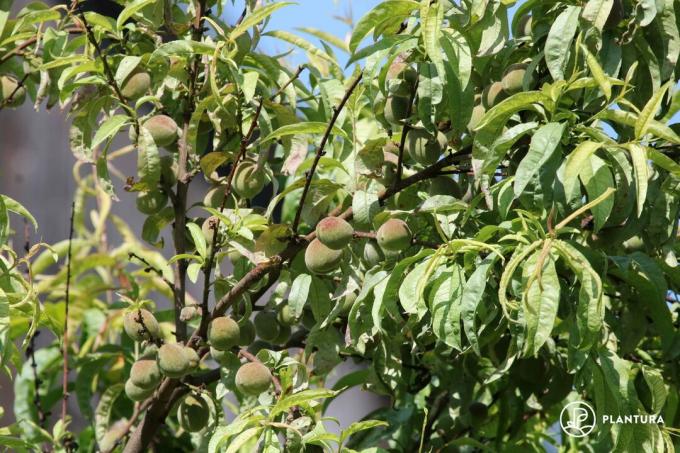
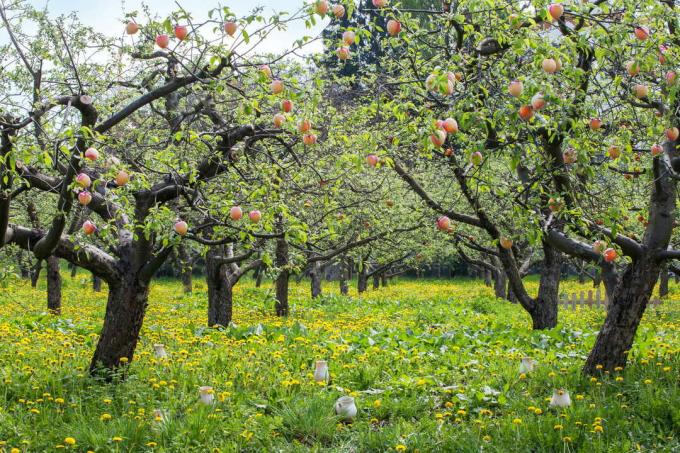
Originally from Asia, the peach (prunus persica) A well-known fruit tree in the Mediterranean region as early as the Middle Ages and finally found in the 19th Century the increased entry into the German gardens. This heat-loving fruit tree species not only impresses with its numerous variations and varieties, but can also thrive in the home garden with the right care.
Hardly any other fruit is as much a part of summer as the peach. With its sweet taste and juicy flesh, it is made for the hot season. You don't have to fly peaches in from the south, you can simply grow them yourself in the garden. In this article, you will learn everything from planting to cutting a peach tree.
contents
- Peach tree: a wanted poster
- Buying a peach tree: this is important to note
-
Plant a peach tree
- Peach tree: suitable location
- Planting a peach tree: the procedure
- Transplant peach tree
-
Caring for the peach tree properly
- Water and fertilize the peach tree
- Peach tree: Further care measures
-
Cut the peach tree correctly
- When to cut the peach tree?
- Peach tree how to cut?
- Peach tree: Common pests
- Peach tree: common diseases
Peach tree: a wanted poster
The peach originally comes from China, but found its way to the aristocratic courts in the Mediterranean area and finally also to German gardens in the Middle Ages. Here it is valued above all for its sweet fruits, but also for its biodiversity. Depending on the variety, the peach can be between one meter (dwarf peach) and a stately eight meters high.

In Germany, however, it is only three to four meters high on average, but with the right care it can be up to 25 to 40 years old. The peach develops its pink flower dress - depending on the variety - in March or April. Its fruits are then ready for harvest between July and September. The peach tree already bears this after one or two years. The peach prefers to be in full sun, warm locations where it stands protected. The soil here should preferably be loose and rich in humus, preferably loamy to sandy.
Buying a peach tree: this is important to note
In order for a peach tree to flourish in the garden and not perish, you should pay attention to a few special features when buying and choosing the trees. First of all, choosing the right variety is essential for a good harvest. In Germany, a hardy variety of the otherwise heat-loving peach should be chosen, such as 'Pilot' or 'Amsden'. Late ripening varieties such as the vineyard peach, on the other hand, should only be grown in typical wine-growing areas in southern Germany, as otherwise there is a risk of crop failures due to early frost. When choosing, you should also pay attention to the disease resistance of the trees, here there is meanwhile a large number of varieties, most of which are immune to diseases such as the Frizziness are.
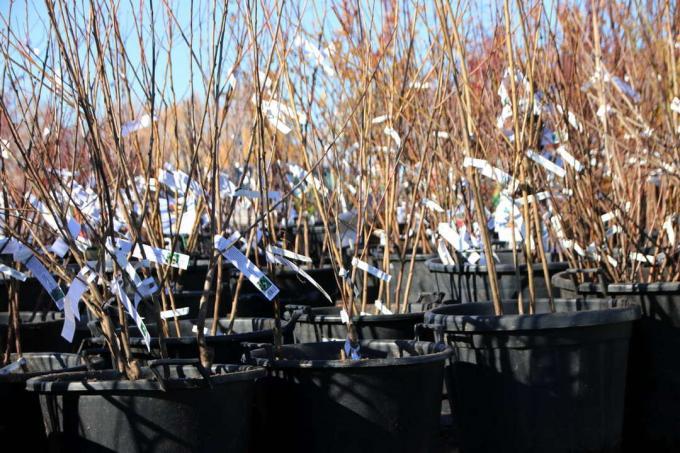
The soil conditions are also important for a good yield, so there are varieties that can grow well on dry soils as well as varieties that can grow on moist soils. Therefore, seek advice from a suitable specialist before purchasing.
Plant a peach tree
After purchasing a peach, you can plant it in a suitable spot in your garden. The ideal time to plant the tree is in autumn. This allows the trees to acclimate to the new location before they shoot for the first time. Alternatively, you can still plant in spring, as soon as frost-free soil allows this. It is important to ensure that the risk of late frost is as low as possible, as this can cause serious damage to young trees. The most important thing when planting is the right location for your tree.
Peach tree: suitable location
The peach is a warmth-loving plant that thrives particularly well in full sun locations. Places exposed to the cold north or east winds are not suitable, as are regions in which there are regular late frosts in spring. Soils suitable for peaches are rich in nutrients and humus, but poor in lime. In particular, slightly loamy soils are well suited for growing peaches, but sandy soils can also become a good location for the tree by adding humus. Heavy soils, on the other hand, should be loosened up generously before planting.
In addition to the soil quality, the water balance should also be taken into account. The peach does not tolerate waterlogging, but if it becomes too dry, it often only bears small fruits and loses them early. Since the peach does not have competitive roots, care should be taken to plant the tree at a sufficient distance from other trees and shrubs. As a rule of thumb, the distance from half a growth width to the next tree should be seen.
Planting a peach tree: the procedure
First, the soil should be loosened up deeply. It is important to ensure that the water drains well, otherwise waterlogging will result. The hole for the peach tree should be about twice as deep and wide as the base of the tree. However, the plant must not be buried too deep - the grafting points should be visible a few centimeters above the ground. Before planting, the roots should be watered extensively; in bare-root trees, the main roots should be freshly cut. The peach tree can be secured against strong winds with a plant stake so that it grows optimally.
A detailed guide to the Planting a peach tree You will find here.
Transplant peach tree
The peach tree should be transplanted once or twice in its first years. This measure promotes the growth of the roots and dead or diseased roots can be removed. Since peaches are neither shallow nor deep roots, it can be assumed as a rule of thumb that the roots are about as wide as the crown and up to a meter deep in the earth.
Older trees, on the other hand, should no longer be replanted. Due to the strong branching of the roots, there is a high risk of numerous root injuries or even cuts, which can lead to the tree shrinking, if the tree is moved late.
Caring for the peach tree properly
The peach is one of the more demanding fruit trees, so proper care is essential for a successful harvest. But with the right tricks, the peach will also bloom splendidly in hobby gardens.
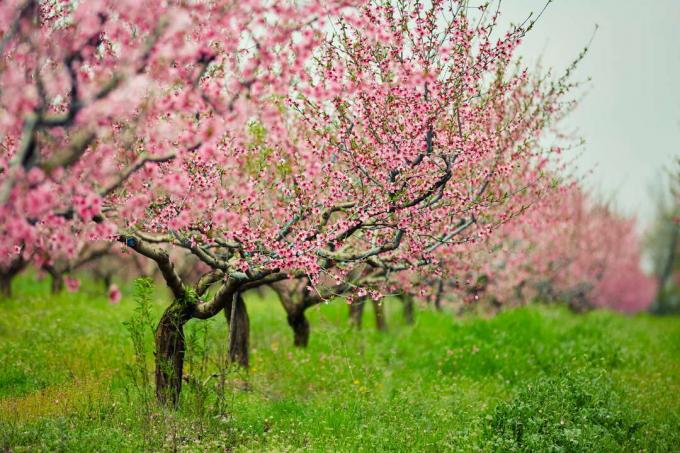
Water and fertilize the peach tree
A balanced water balance is essential for the growth of your peach tree. In the first year in particular, care should be taken to water the tree regularly so that it does not lose its fruit. Rainwater should be used here, as the peach is sensitive to the lime contained in tap water. If there is no way to collect rainwater, you can also let tap water stand for a week. The lime settles on the ground and the water can then (without the lime-containing sediment) be used for watering. Older trees, on the other hand, can usually supply themselves with water and do not have to be additionally watered.
The peach should be fertilized at regular intervals throughout the entire growing season, i.e. from spring to early autumn. It is important to ensure a balanced nitrogen balance. Long-term fertilizers that only need to be applied in spring and may need to be re-fertilized in summer are particularly suitable. Our Plantura organic universal fertilizer with organic long-term effects. But also biological alternatives such as compost, dung and Horn shavings can be a good alternative if given regularly. As a rule, the peach tree should not be fertilized in the first year, as it can react very sensitively to excess nutrients.
Peach tree: Further care measures
Since the peach tree does not have particularly competitive roots, care should be taken in the first years of standing to keep the tree slice free from any vegetation. In the case of varieties that are particularly susceptible to frost and in particularly long and cold winters, the crown can be covered with a protective hood or fleece to prevent frost damage. Leaving leaves on the ground around the trunk can also help protect the peach tree in severe winters. With mature trees and more robust varieties, however, winter protection is usually not required.
Cut the peach tree correctly
The pruning of the peach tree is one of the most important maintenance measures. Since peaches only fruit on annual wood and quickly bleached without cutting, regular cutting should always be carried out in order to obtain a good harvest and a beautiful tree. At home, too, the right pruning of a peach tree is quick and easy.
When to cut the peach tree?
With the peach tree, as with other fruit tree species, a distinction is made between winter (January to April) and summer pruning (late June to early August). The winter pruning aims to promote growth and promote the sprouting of new shoots. If used correctly, it ensures a good harvest, as the peach bears flowers and thus fruit, especially on its annual shoots. In contrast, the summer pruning slows growth and keeps the tree in shape. Therefore, a combination of both cuts should always be used in order to achieve a balanced ratio in the growth of shoots.
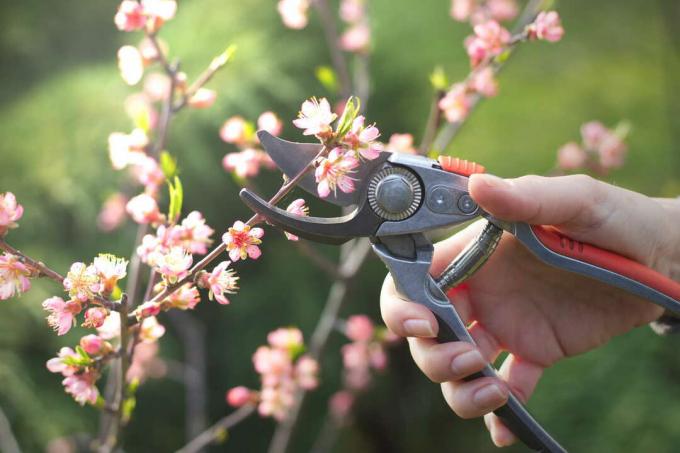
Peach tree how to cut?
The first cut should be made at the time of planting. This so-called plant pruning consists of cutting back all side shoots except for a maximum of five eyes. The same is done with the main shoot, which should clearly protrude beyond the side shoots after the cut. In the next few years, the upbringing will follow, in which the optimal shape and branching of the tree should be promoted. Here, healthy production branches are shortened at the tip of the shoots, while side shoots are sometimes completely removed and sometimes not cut at all. It is advisable to also trim side shoots to encourage the formation of annual wood.
Whether a side shoot should be taken out or left uncut is decided by a peculiarity of the peach. The peach tree develops both real and fake fruit shoots. False fruit shoots can be recognized by the only individually formed flower buds at the nodes and by only one leaf bud at the tip of the shoot. Although they can develop fruits, they lose them early because they cannot adequately supply the fruit. Real fruit shoots, on the other hand, form what are known as triplet buds at each node, consisting of two flower buds sitting next to each other, which are framed by a leaf bud. Since false fruit shoots neither supply the tree nor bear fruit, they should be completely removed from the tree when cutting.
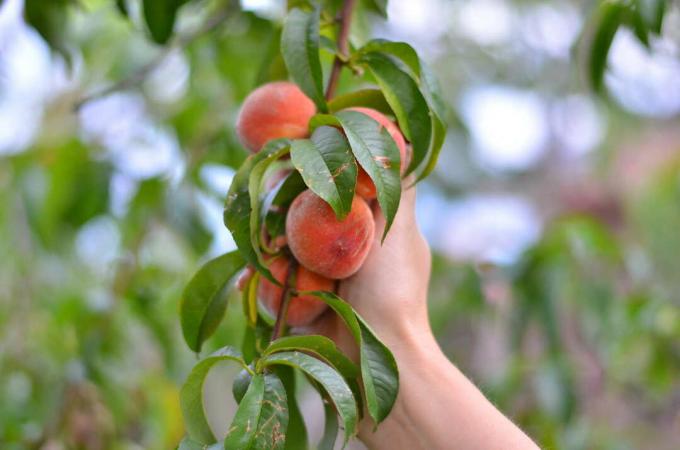
Even with older trees, pruning measures should be carried out regularly. As with young trees, it is advisable to remove false fruiting shoots. Furthermore, the hierarchy between main shoot, leading shoot and side shoots should be supported. To do this, dominant shoots that take too much light from the rest of the tree can be shortened or even removed entirely. Even old shoots that no longer bear fruit can be cut back to make space for young shoots. However, care should be taken to maintain the balance between old and new instincts. As after every care measure, the tree should also be observed after cutting in order to gather conclusions for the next cut, if necessary.
A detailed summary of the correct Pruning measures on your peach tree can be read here.
Peach tree: Common pests
The best known as well as the most common pest on peach trees is the aphid. These damage the plant not only by withdrawing the phloem sap, but can also be carriers of the dreaded curl disease. The aphid can often be seen with the naked eye and, depending on the species, has a green, yellowish or even greyish color. There are also stunted or curled leaves and sparse growth of buds, flowers and fruits. Furthermore, the appearance of honeydew - a sticky liquid that is excreted by aphids - is a clear indication of the pests. If the aphid infestation is low, home remedies such as a stock of nettles can often be sufficient. In the case of severe infestation, however, a chemical insecticide (insecticide) should be used to contain further damage.

Peach tree: common diseases
The most common disease of the peach tree is Frizziness. This disease caused by fungi is mainly visible on the leaves. These show bubble-like elevations and are white-green to red in color. Furthermore, the leaves can curl or curl or even shed them. Effective control is only possible with chemical pesticides (fungicides) and can only take place next spring before the first buds swell. So far, there are no biological measures with a guaranteed effect, but trees that are well cared for and generally healthy are significantly less susceptible than trees that have already been damaged. As a preventive measure, however, you can choose a robust or partially resistant variety, even if this also does not guarantee absolute safety.
If it is not the leaves but the fruits that show signs of disease, it is very likely that it is Monilia fruit rot. The Monilia fungus causes rapidly growing rot on the fruit. These are ring-shaped by what is known as cushion mold, the white fruiting body of the fungus. In the case of infested fruits, total rot follows first, then either falling off or wintering on the tree as a fruit mummy. The fungus often overwinters in these fruit mummies and then spreads again in spring. Therefore, all infected fruits should be collected and infected branches cut back down to the healthy wood. To prevent a new outbreak, the waste should not end up on the compost, but rather be burned or buried.

The last major disease is gum flow (Gummy dose), even if this is less of a disease and more of a symptom. The gum flow can appear as a sign of a disease, but it can also be caused by unfavorable growth conditions or injuries to the bark. The tree "bleeds" an amber-colored, sticky mass that is often mistaken for resin. Robust varieties should be chosen as a precaution, but proper care and a white coating to prevent frost cracks can also help. In the event of an infestation, the affected branches should be cut off generously with disinfected scissors to prevent the disease from spreading.
Before a peach tree finds its place in your garden, it is important to choose the right variety. We'll provide you most popular peach varieties for the culture before.
